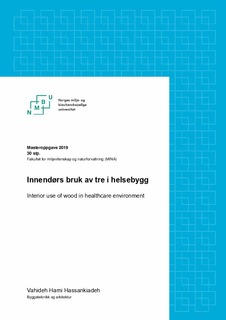| dc.contributor.advisor | Nyrud, Anders Qvale | |
| dc.contributor.author | Hami Hassankiadeh, Vahideh | |
| dc.coverage.spatial | Norway, Trondheim | nb_NO |
| dc.date.accessioned | 2019-08-21T12:11:26Z | |
| dc.date.available | 2019-08-21T12:11:26Z | |
| dc.date.issued | 2019 | |
| dc.identifier.uri | http://hdl.handle.net/11250/2609544 | |
| dc.description.abstract | Focus on the use of renewable materials in new buildings is very relevant in today’s society. This is because buildings including the industry sector account for 27 percent of greenhouse gas emissions leading to global warming. This value is 52 percent if power consumption and heat production are taken into account (Edenhofer et al., 2014). This is important for people's health, especially physical health, which in turn affects our mental health. Society needs new knowledge and methods in building and health in order to contribute to better indoor climate
The goal of this study had been to find out whether natural materials such as wood in hospital buildings could affect the patients' improvement process. The thesis was inspired by previous studies focusing on the effect of nature on human health. We should consider whether using natural elements in buildings could be a good alternative to nature, since we in modern society not always have access to nature in everyday life.
This experiment was done at St. Olav Hospital in Trondheim during the period 2009 to 2011. Oak and birch plates were installed in selected rooms at the Orthopedic Department. These two room types were compared to regular hospital rooms that had artworks and landscape pictures on the walls, to determine whether wooden boards could affect stress and pain levels as well as length of stay for the users of the four room types. The study also considered the effect of types of operations on the factors above. The effect of wood species and types of operations together were also considered in the study.
The analysis showed that wood types did not have a significant impact on psychological outcomes such as stress and pain levels. Types of surgery showed a significant difference in the level of pain, while it did not have any significant impact on stress levels. Patients undergoing hip surgery had significantly lower pain than patients who underwent knee surgery. Assessment of room types and types of surgery together also had a significant impact on stress and pain levels. Neither room types nor operating types, or the two factors together did affect the length of stay at the same time. Similarities were observed between wooden rooms and rooms with art pieces, and this might be related to the fact that art can have equally positive effects on people as natural materials. | nb_NO |
| dc.description.abstract | Fokus på bruk av fornybare materialer i nybygg er svært aktuelt i dagens samfunn. Dette er fordi bygninger (inkludert industrisektoren) står for 27 prosent av klimagassutslippene som fører til global oppvarming. Denne verdien er 52 prosent hvis strømforbruket og varmeproduksjon tas med i betraktning (Edenhofer et al., 2014). Dette har betydning for menneskers helse, særlig fysisk helse som igjen påvirker vår psykiske helse. Samfunnet trenger ny kunnskap og metoder innen bygg og helse for å kunne bidra til bedre inneklima og mindre forurensning.
Målet med denne studien var å finne ut hvorvidt naturlige materialer som tre i sykehusbygg kunne påvirke pasientenes forbedringsprosess. Oppgaven var inspirert av tidligere studier med fokus på effekt av natur på menneskers helse. Vi skulle vurdere om bruk av naturlige elementer i bygg kunne være et bra alternativ til naturen, siden man i det moderne samfunnet ikke alltid har tilgang til natur i hverdagen.
Studien tok for seg en undersøkelse gjennomført på St. Olavs Hospital i Trondheim i perioden 2009 til 2011. Her ble det montert eike- og bjørkeplater i utvalgte rom på Ortopedisk avdeling. De to romtypene ble så sammenlignet med vanlige sykehusrom med kunstbilder og landskapsfotografi for å finne ut hvorvidt treplatene kunne ha effekt på stress- og smertenivå samt liggetid for brukerne av de ulike romtypene. Studien tok også i betraktning hvilken effekt ulike operasjonstyper hadde på faktorene overfor. Effekt av treslag og operasjonstyper til sammen ble også vurdert i denne studien.
Analysen viste at treslag ikke hadde en signifikant påvirkning på psykologiske utfall som stressog smertenivå. Operasjonstyper viste en signifikant forskjell på smertenivå, mens den ikke hadde noe særlig betydning for stressnivå. Pasienter som gjennomgikk hofteoperasjon hadde betydelig lavere smerte enn pasienter som gikk gjennom kneoperasjon. Vurdering av romtyper og operasjonstyper til sammen hadde også en signifikant påvirkning på stress- og smertenivå. Liggetid ble ikke påvirket av hverken romtyper eller operasjonstyper, eller de to faktorene i kombinasjon. Det ble imidlertid observert likheter mellom trerom og kunstrom, og dette kan ha sammenheng med at kunst kan ha like positive effekt på mennesker som naturlige materialer. | nb_NO |
| dc.language.iso | nob | nb_NO |
| dc.publisher | Norwegian University of Life Sciences, Ås | nb_NO |
| dc.rights | Attribution-NonCommercial-NoDerivatives 4.0 Internasjonal | * |
| dc.rights | Attribution-NonCommercial-NoDerivatives 4.0 Internasjonal | * |
| dc.rights.uri | http://creativecommons.org/licenses/by-nc-nd/4.0/deed.no | * |
| dc.title | Innendørs bruk av tre i helsebygg | nb_NO |
| dc.title.alternative | Interior use of wood in healthcare environment | nb_NO |
| dc.type | Master thesis | nb_NO |
| dc.source.pagenumber | 59 | nb_NO |

